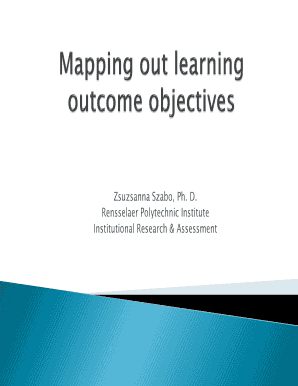
Bloom's Revised Taxonomy Form


What is Bloom's Revised Taxonomy
Bloom's Revised Taxonomy is an educational framework that categorizes cognitive skills into levels of complexity and specificity. Originally developed by Benjamin Bloom in the 1950s, it was updated in the 1990s to reflect modern educational practices. The taxonomy consists of six levels: remembering, understanding, applying, analyzing, evaluating, and creating. Each level builds upon the previous one, guiding educators in designing learning objectives and assessments that promote higher-order thinking.
How to Use Bloom's Revised Taxonomy
To effectively use Bloom's Revised Taxonomy, educators can align their teaching methods and assessment strategies with the cognitive levels outlined in the framework. This involves creating learning objectives that specify desired outcomes at various levels of thinking. For instance, teachers can develop activities that encourage students to remember facts, understand concepts, apply knowledge in practical situations, analyze information, evaluate arguments, and create original work. By structuring lessons around these levels, educators can foster deeper understanding and critical thinking skills among students.
Key Elements of Bloom's Revised Taxonomy
The key elements of Bloom's Revised Taxonomy include the cognitive process dimensions and the knowledge dimensions. The cognitive process dimensions consist of the six levels of thinking, while the knowledge dimensions categorize the types of knowledge that learners are expected to acquire: factual, conceptual, procedural, and metacognitive. Understanding these elements helps educators create a comprehensive approach to teaching that addresses both what students need to know and how they can demonstrate their understanding.
Examples of Using Bloom's Revised Taxonomy
Examples of applying Bloom's Revised Taxonomy can be seen in various educational settings. For instance, in a science class, a teacher might ask students to remember the steps of the scientific method (remembering), explain how to conduct an experiment (understanding), design their own experiment (applying), compare different scientific theories (analyzing), assess the validity of a study (evaluating), and propose a new hypothesis based on their findings (creating). These examples illustrate how educators can use the taxonomy to develop a range of activities that promote higher-order thinking.
Steps to Complete the Bloom's Revised Taxonomy
Completing tasks aligned with Bloom's Revised Taxonomy involves several steps. First, educators should identify the learning objectives they wish to achieve. Next, they can select appropriate activities and assessments that correspond to the desired cognitive levels. After implementing these activities, educators should evaluate student performance and understanding, adjusting their teaching strategies as necessary. This iterative process ensures that learning remains focused on developing critical thinking skills and deeper comprehension.
Legal Use of Bloom's Revised Taxonomy
While Bloom's Revised Taxonomy itself is an educational framework and not subject to legal restrictions, its application in educational settings must comply with relevant laws and regulations. For example, when developing curricula or assessments based on the taxonomy, educators should ensure that they adhere to educational standards and guidelines established by state and federal authorities. Additionally, considerations regarding accessibility and inclusivity are essential to ensure that all students can benefit from the learning opportunities created using this framework.
Quick guide on how to complete blooms revised taxonomy
Prepare [SKS] effortlessly on any device
Online document management has gained popularity among businesses and individuals alike. It offers a perfect eco-friendly solution to traditional printed and signed documents, allowing you to locate the appropriate form and securely save it online. airSlate SignNow equips you with all the tools necessary to create, modify, and eSign your documents swiftly without any delays. Manage [SKS] on any platform with airSlate SignNow Android or iOS applications and simplify any document-related task today.
The easiest way to modify and eSign [SKS] without hassle
- Obtain [SKS] and then click Get Form to begin.
- Utilize the tools we offer to fill out your form.
- Emphasize pertinent sections of the documents or redact sensitive information with tools that airSlate SignNow provides specifically for this purpose.
- Craft your signature using the Sign feature, which takes mere seconds and carries the same legal validity as a conventional ink signature.
- Review the details and click on the Done button to save your changes.
- Decide how you wish to send your form: via email, SMS, or invite link, or download it to your computer.
Eliminate concerns regarding lost or misplaced files, tedious form searching, or errors that necessitate printing new document copies. airSlate SignNow addresses all your document management needs in just a few clicks from any device you prefer. Modify and eSign [SKS] and ensure superb communication at any stage of your form preparation process with airSlate SignNow.
Create this form in 5 minutes or less
Related searches to Bloom's Revised Taxonomy
Create this form in 5 minutes!
How to create an eSignature for the blooms revised taxonomy
How to create an electronic signature for a PDF online
How to create an electronic signature for a PDF in Google Chrome
How to create an e-signature for signing PDFs in Gmail
How to create an e-signature right from your smartphone
How to create an e-signature for a PDF on iOS
How to create an e-signature for a PDF on Android
People also ask
-
What is Bloom's Revised Taxonomy and how does it relate to airSlate SignNow?
Bloom's Revised Taxonomy is a framework that categorizes educational goals and objectives. In the context of airSlate SignNow, it helps users understand how to effectively utilize our eSigning features to enhance learning and productivity. By aligning document workflows with Bloom's principles, businesses can improve their training and assessment processes.
-
How can airSlate SignNow help in implementing Bloom's Revised Taxonomy in educational settings?
airSlate SignNow provides tools that facilitate the creation and management of documents that align with Bloom's Revised Taxonomy. Educators can easily design assessments and learning materials that promote higher-order thinking skills. Our platform streamlines the eSigning process, making it easier for educators to focus on teaching rather than paperwork.
-
What are the pricing options for airSlate SignNow?
airSlate SignNow offers flexible pricing plans to accommodate various business needs. Our plans are designed to be cost-effective while providing access to features that support the implementation of Bloom's Revised Taxonomy. You can choose from monthly or annual subscriptions, ensuring you find a plan that fits your budget.
-
What features does airSlate SignNow offer to support Bloom's Revised Taxonomy?
Our platform includes features such as customizable templates, automated workflows, and real-time collaboration tools. These features enable users to create documents that align with Bloom's Revised Taxonomy, fostering a more engaging learning experience. Additionally, our user-friendly interface ensures that anyone can utilize these tools effectively.
-
Can airSlate SignNow integrate with other educational tools?
Yes, airSlate SignNow seamlessly integrates with various educational tools and platforms. This integration allows users to enhance their workflows while implementing Bloom's Revised Taxonomy in their teaching strategies. By connecting with tools like Learning Management Systems (LMS), educators can streamline document management and eSigning processes.
-
What are the benefits of using airSlate SignNow for businesses focused on Bloom's Revised Taxonomy?
Using airSlate SignNow can signNowly enhance the efficiency of document management in businesses that prioritize Bloom's Revised Taxonomy. Our platform simplifies the eSigning process, allowing teams to focus on developing educational content that promotes critical thinking. This leads to improved productivity and better outcomes in training and assessment.
-
Is airSlate SignNow suitable for small businesses looking to implement Bloom's Revised Taxonomy?
Absolutely! airSlate SignNow is designed to be a cost-effective solution for businesses of all sizes, including small enterprises. By utilizing our platform, small businesses can easily create and manage documents that align with Bloom's Revised Taxonomy, ensuring they meet educational goals without breaking the bank.
Get more for Bloom's Revised Taxonomy
- Revocation of postnuptial property agreement michigan michigan form
- Michigan property 497311279 form
- Postnuptial property agreement 497311280 form
- Quitclaim deed from husband and wife to an individual michigan form
- Warranty deed from husband and wife to an individual michigan form
- Warranty deed trust to individual michigan form
- Michigan affidavit 497311284 form
- Notice commencement 497311285 form
Find out other Bloom's Revised Taxonomy
- eSign Non-Profit PPT Kentucky Safe
- eSign Indiana Non-Profit Permission Slip Fast
- eSign Nevada Legal LLC Operating Agreement Online
- eSign Nevada Legal LLC Operating Agreement Computer
- eSign Nevada Legal LLC Operating Agreement Mobile
- eSign Indiana Non-Profit Permission Slip Simple
- eSign Nevada Legal LLC Operating Agreement Now
- eSign Nevada Legal LLC Operating Agreement Later
- How To eSign Nevada Legal LLC Operating Agreement
- eSign Nevada Legal LLC Operating Agreement Myself
- eSign Indiana Non-Profit Permission Slip Easy
- eSign Nevada Legal LLC Operating Agreement Free
- eSign Nevada Legal LLC Operating Agreement Secure
- How Do I eSign Nevada Legal LLC Operating Agreement
- eSign Nevada Legal LLC Operating Agreement Fast
- eSign Nevada Legal LLC Operating Agreement Simple
- eSign Indiana Non-Profit Permission Slip Safe
- Help Me With eSign Nevada Legal LLC Operating Agreement
- eSign Nevada Legal LLC Operating Agreement Easy
- eSign Nevada Legal LLC Operating Agreement Safe